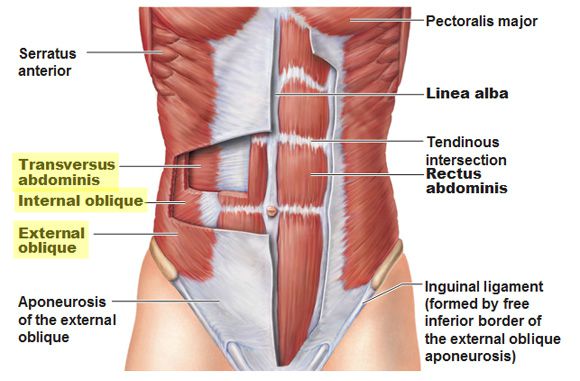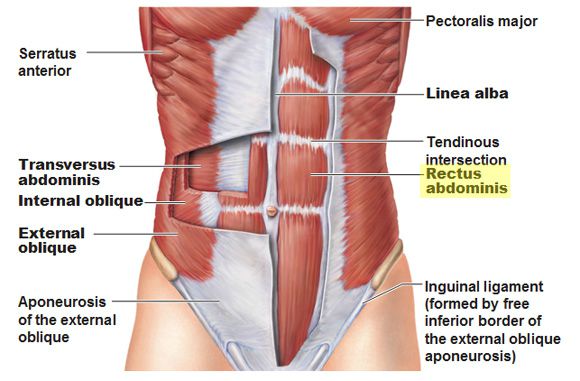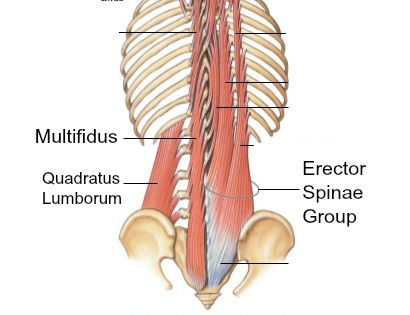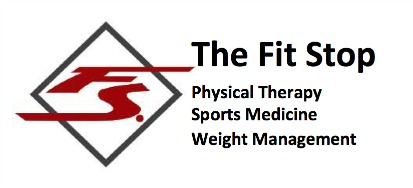What are the core muscles and how do I strengthen them?
What is the core? Whenever I refer to “core” in my clinic with my patients, I am referring specifically to the muscles of the trunk and hips. This area is referred to as the “core” or center of your body and is vital in almost all functional movements. Proper muscle activation in the core is vital to strong, healthy, and pain-free movement. Here are the specific muscles and essential movements that are vital to maintaining a strong, healthy core:
 1. Transversus abdominis: this is the deepest muscle of the abdominal wall. In regards to core and spine stability it is also one of the most important (you’ve probably heard your physical therapist talk at length about this one!). It starts from your spine and wraps around all the way to a central attachment site in the front of your abdomen; essentially forming a corset around your midsection. This muscle is vital to spinal stability and is contracted as you draw your belly button up and in towards your spine. My first step in all core exercises in the clinic is always to contract your TA (suck in your stomach towards your spine).
1. Transversus abdominis: this is the deepest muscle of the abdominal wall. In regards to core and spine stability it is also one of the most important (you’ve probably heard your physical therapist talk at length about this one!). It starts from your spine and wraps around all the way to a central attachment site in the front of your abdomen; essentially forming a corset around your midsection. This muscle is vital to spinal stability and is contracted as you draw your belly button up and in towards your spine. My first step in all core exercises in the clinic is always to contract your TA (suck in your stomach towards your spine).
2. Obliques: the next layers of your abdominal wall musculature is your internal and external obliques. These muscles wrap from your hips to your ribs (or from ribs to your hips: internal versus external obliques) and are essential in controlling lateral and rotary movements of the core. Exercises including side planks and bicycle crunches are great ways to activate your obliques.
 3. Rectus abdominis: the “six pack” muscle. This is your most superficial layer of abdominal musculature which runs the front of your abs from the bottom of your ribs to the top of your pelvis. This is the primary mover during trunk flexion activities, specifically sit ups, crunches, etc. While this bad boy probably gets the most attention, it’s not necessarily the most vital in talking about core strength and spine stability.
3. Rectus abdominis: the “six pack” muscle. This is your most superficial layer of abdominal musculature which runs the front of your abs from the bottom of your ribs to the top of your pelvis. This is the primary mover during trunk flexion activities, specifically sit ups, crunches, etc. While this bad boy probably gets the most attention, it’s not necessarily the most vital in talking about core strength and spine stability.
 4. Quadratus lumborum, multifidus, erector spine group: These are the muscles that make up the lower back region. The quadratus lumborum and multifidus are vital to lumbar spine stability, strength, and preventing injury. The best exercises for these muscles include bridges and bird dogs. The erector spinae group are the primary movers in back extension activities (bending backwards including Superman extensions, Roman chair back extensions, etc.).
4. Quadratus lumborum, multifidus, erector spine group: These are the muscles that make up the lower back region. The quadratus lumborum and multifidus are vital to lumbar spine stability, strength, and preventing injury. The best exercises for these muscles include bridges and bird dogs. The erector spinae group are the primary movers in back extension activities (bending backwards including Superman extensions, Roman chair back extensions, etc.).
5. Hip musculature: This group is comprised of the hip flexors (planks and straight-leg raises), abductors (side lunges and side planks), and extensors (bridges and dead lifts). Strong hips play an integral role in performance of normal daily function including squatting, lunging, bending, and lifting. Weak hips are one of the key factors I find in patients complaining of everything from back pain to knee instability. These muscles are vital to strong, healthy, functional movement.
Knowing these important muscles and their primary functions is essential to training them appropriately. As you can see, “core strengthening” is so much more than sit ups and crunches. It is vital to incorporate movements in all planes (front-to-back, side-to-side, rotation) and using all these different muscle groups. Mix up your core routines by adopting some of these principles and watch the results take off!
Are you experiencing pain in your back or hips? Maybe you would just like some more guidance as to strengthening you core. We here at Fit Stop Physical Therapy would love to help you out! Contact one of our convenient locations by clicking the links found here…
Heber City Downtown Salt Lake Farmington Murray
Jared Beckstrand, PT, DPT
Fit Stop Physical Therapy – Farmington
172 N East Promontory Ste 200
Farmington, UT 84025
(801) 558-8612


